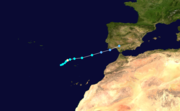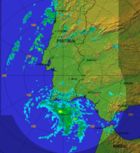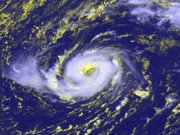Hurricane Vince (2005)
2008/9 Schools Wikipedia Selection. Related subjects: Natural Disasters
| Category 1 hurricane ( SSHS) | ||
|---|---|---|
|
Hurricane Vince on October 9 14:23 UTC |
||
| Formed | October 8, 2005 | |
| Dissipated | October 11, 2005 | |
| Highest winds |
|
|
| Lowest pressure | 988 mbar ( hPa; 29.19 inHg) | |
| Fatalities | None reported | |
| Damage | Unknown | |
| Areas affected |
Madeira Islands, southern Portugal, southwestern Spain | |
| Part of the 2005 Atlantic hurricane season |
||
Hurricane Vince was one of the most unusual hurricanes ever to develop in the Atlantic basin, forming in October during the 2005 Atlantic hurricane season. Vince was the 20th named tropical cyclone and twelfth hurricane of the extremely active season.
Vince developed from a non-tropical system on October 8, becoming a subtropical storm southeast of the Azores. The National Hurricane Centre did not officially name the storm until the next day, shortly before Vince briefly became a hurricane. Vince then made an unprecedented landfall on the Iberian Peninsula on October 11 as a tropical depression, dissipating over Spain.
Storm history
On October 5, an operationally unnamed subtropical storm that had gone unnoticed was absorbed by a non-tropical frontal low, which was moving to the southeast over the Azores. It began to gain a more concentrated circulation and lose its frontal structure after absorbing the Subtropical Storm. The increasingly organized system became a subtropical storm itself early on October 8, 580 miles (930 km) southeast of the Azores. However, the National Hurricane Centre decided not to name the system Vince at the time, because the water temperature was too low for a tropical cyclone to normally develop. Vince gradually gained more tropical characteristics and became a tropical storm the next day, over water cooler than 24 °C (75 °F), which defies general thought that sea surface temperatures of at least 26.5°C (80°F) are required for a tropical storm to form and intensify.
Soon after it had become a tropical storm on October 9, the NHC officially named Tropical Storm Vince when it was near Madeira and began to issue advisories. There was still some uncertainty as to whether Vince was tropical or subtropical at this time and the forecasters of the NHC conceded that Vince may have already been a subtropical storm before it was named. Vince reached its peak as a hurricane with 75 mph (120 km/h) winds later that day, the National Hurricane Centre deciding that "if it looks like a hurricane — it probably is — despite its environment and unusual location".
Hurricane Vince immediately began to weaken in response to increasing westerly shear and soon became a tropical storm again. Vince continued to weaken as it approached the Iberian Peninsula and became a tropical depression shortly before it made landfall near Huelva, Spain on October 11. The fast-moving tropical depression soon dissipated over land.
Impact
No damages or fatalities were reported from Hurricane Vince. The highest winds reported on land were 77 km/h (48 mph) at Jerez, Spain, though some ships recorded stronger winds. Vince was comparable to normal rain events from non-tropical systems, with only 1 to 2 inches (25 to 50 mm) of rain falling. Through a play on words of a song in My Fair Lady, National Hurricane Centre forecaster James Franklin in the Tropical Cyclone Report for Vince wrote, "the rain in Spain was mainly less than 2 inches, although 3.30 inches (84 mm) fell in the plain at Cordoba."
Records and naming
Although Hurricane Vince was a very small and short-lived storm, it is notable for developing in the northeastern Atlantic off the Moroccan coast, well away from where tropical cyclones are usually found. It is the farthest northeast a tropical cyclone had ever developed in the Atlantic (32.9°N 20.6°W); previously the record was held by Ivan of the 1980 season, at 35.6°N and 24.6°W. Vince is neither the most northerly-forming nor the most easterly-forming Atlantic tropical storm; these records are held by Alberto of the 1988 season at 41.5°N, and Ginger of the 1967 season at 18.1°W, respectively.
Hurricane Vince developed into a hurricane further east than any known storm at 18.9°W. Vince is the first tropical cyclone on record to have made landfall on the Iberian Peninsula, after coming ashore near Huelva, Spain.
When Subtropical Storm Vince formed on October 8, it was the earliest ever in the season that the twenty-first tropical or subtropical storm had developed, 38 days ahead of the previous record held by Tropical Storm 21 of the 1933 season. Hurricane Vince was also the first named "V" storm in the Atlantic since naming began in 1950. Due to the lack of any significant effects from Hurricane Vince, the name was not retired by the World Meteorological Organization and will be on the list of names for the 2011 season.



